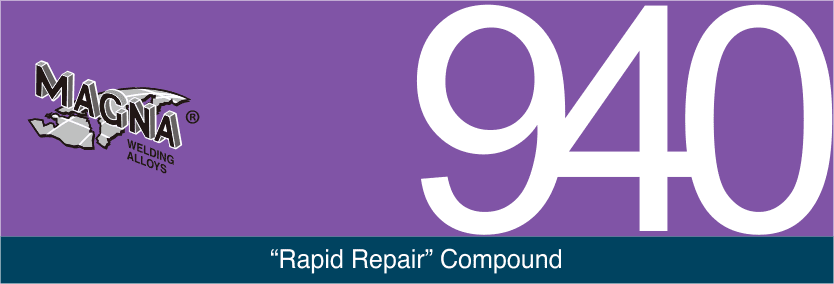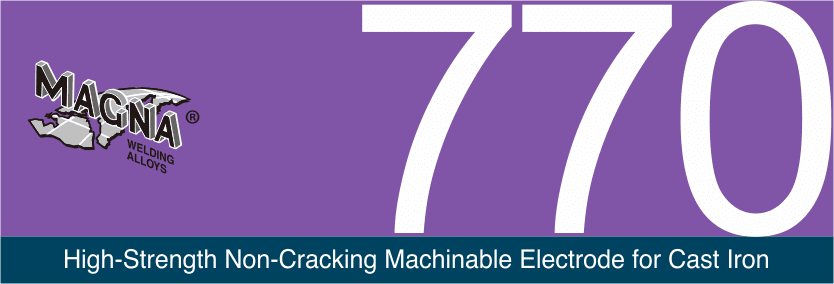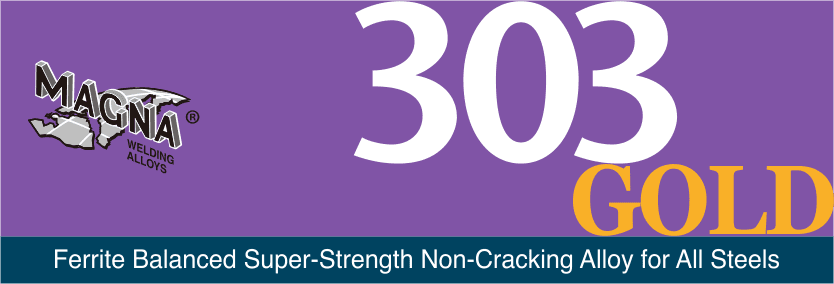For Any Queries Call Us at +91 91360 26188

Magna electrodes
Magna 940
- June 10, 2021
- No Comments
Magna 940 Magna Electrodes Trust Magna 940 – Ease of Application – Wide Versatility – Outstanding Physical Properties Patches and seals virtually any material. Repairs in 15 minutes – hardens in an hour. Easy to use – requires no special tools or training. Works on wet surfaces – even under water! SPECIAL FEATURESMagna 940 “Rapid Repair” Compound is the breakthrough “helper” for hundreds of minor repairs for metal and other materials.• Magna 940 forms a reliable and durable patch or seal in as little as 15 minutes and fully hardens in less than an hour.• Magna 940 is easy to use – requires no special tools or training.• Magna 940 quickly adheres to almost any surface, even under water. OUTSTANDING PROPERTIESMagna 940 is the super rapid repair compound that:• Features an advanced rosin compound with special fillers, including bronze powder.• Can be machined, drilled, filed or tapped when fully cured.• Is non-magnetic for use around gauges and other sensitive metering devices.• Is formulated to be chemically resistant and extremely corrosion resistant. USE FORMagna 940 “Rapid Repair” is the compound you apply in three easy steps:1. Cut off exactly the amount required – no waste.2. Knead product to mix the co-reactors.3. Apply onto surface to be repaired. Use Magna 940 “Rapid Repair” for• Virtually All Metals • PVC • Glass • Wood • Concrete • Ceramic • Brick • Tile • Porcelain • Plastic Surfaces Magna 940 is a totally new type of Instant Repair Compound that provides every workshop with the means to make speedy and sound repairs on surfaces and parts made of steel, copper, aluminium, cast iron, stainless, galvanized, brass and chrome. It features many advantages over conventional weld repair methods, especially where heat input using gas rod or electrode would require extensive dismantling, heat screening, re-assembly or even difficult access – such as in on-site work, or at height or using scaffolds. No special tools or training are required to successfully apply Magna 940 and, where required, It can be machined, drilled, filed or tapped after fully curing. Repairs can be completed in as little as 15 minutes and full cure is obtained in about 1 hour. Magna 940 is an advanced resin compound with special fillers engineered into it, including bronze powder, to give the product these special features:∙ Will not rust or oxidize∙ Product is non-magnetic and can be used in and around gauges and other sensitive metering devices or apparatus.∙ It is chemical resistant and extremely corrosion resistant.∙ The product works fast – -and yet can be re-shaped for a full 5 minutes after applying as initial curing takes place in 15 minutes and full cure is attained in 1 hour.∙ Magna 940 will adhere even to damp or wet surfaces and will even cure while immersed completely in water or other non-reactive liquid media.∙ There is no waste as the operator can use only the exact the amount required without contamination problems with the left over portions of the product.∙ Magna 940 has an indefinite shelf life when stored properly and its handle, carry-anywhere size makes it perfect for virtually any type of on-job repairseven in remote sites.∙ This product can be used as a sealant, adhesive, putty or cement and can be used on non-ferrous applications such as, PVC, glass, wood, concrete, ceramic, brick, tile, porcelain and plastic surfaces and parts equally as effectively as when used on metals. PRECAUTIONSMagna 940 can be used for a multitude of maintenance and repair applications. It may cause irritation to sensitive skin and surgical gloves are recommended for most situations. Wash hands with soap and water after using product. In case of eye contact, flush with copious amounts of water and contact physician. May be harmful if swallowed. Magna 940 was engineered for professional or industrial applications and should be kept out of reach of children. SPECIFICATIONS• TENSILE STRENGTH: 8,200 p.s.i. (5.77kg/mm2)• COMPRESSIVE STRENGTH: 19,000 p.s.i. (13.36kg/mm2)• SHEAR STRENGTH: 950p.s.i. (0.67 kg/mm2)• SHORE “D” HARDNESS: 90• MAX. OPERATING TEMPERATURE: 550oF(288oC)-INTERMITTENT 500oF(260Oc) – CONTINUOUS• WORKING TIME: 5 minutes (before initial cure)• CURING TIME: 60 minutes (@20Oc, RH50%)• MODULES OF ELASTICITY: 6 X 105 p.s.i.• VOLUME RESISTIVITY: 5 X 1015 Ohm-cm• DIELECTRIC STRENGTH: 400 volts/mil@0.125 power m• SHELF LIFE 2 YEARS APPLICATION:Applying Magna 940 is simple and foolproof and no tools or special equipment is necessary.1. Uncap the tube holder.2. Unwrap from plastic protector and peel off the foil paper at one end.3. Use a knife or a pair of scissors and cut off a portion of Magna 940 sufficient for the repair you wish to apply it to. Replace foil paper, rewrap in plastic and return to tube holder.4. Mix the it by kneading the portion thoroughly using your fingers or by rubbing it with your palms on a flat clean surface. 5. It will give off a slight amount of heat when kneading. This a natural and nothing to be alarmed about.6. Work it into the part(s) to be repaired or sealed. Press the product firmly into the piece to be repaired to ensure it fully covers the area and to enable it to work into any recesses present.7. Re-shape the Magna 940 rapidly to the desired shape (within 2 to 5 minutes of initial mixing).8. Should a smooth surface finish be desired, hand rub the Magna 940 with some water or use a damp spatula to smooth out any rough edges or ribs. (You must do this within 5 minutes of initial mixing.)9. Magna 940 attains full cure in 60 minutes and can them be machined, filed, tapped, drilled, etc. Download PDF Also Read Shielding Gas Mixtures MILLER WIRE FEEDER S-74D MPA PLUS Dissolvable alignment sticks for welding Caution and weld backing tape Purge gas retaining tape for welding Pipe purging inflatable bladders for welding Aquasol socket weld spacer rings Oxygen monitor system for welding Water Soluble Purge Dam Anti heat protective heat sink compound Previous PostNext Post
Magna 770
- June 9, 2021
- No Comments
Magna 770 Magna Electrodes Trust Magna 770 – Ease of Application – Wide Versatility – Outstanding Physical Properties Gives perfect machinable welds on practically all types of cast iron. Outstanding elongation of electrode positively prevents cracking. Has higher tensile strength than most types of cast iron. SPECIAL FEATURESMagna 770 High-Strength Non-Cracking Machinable Electrode for Cast Iron is a metallurgical breakthrough!• Magna 770 is an ideal maintenance electrode, giving perfect, totally machinable welds on practically all types of cast iron.• Magna 770’s excellent elongation make-up allows the weld metal to stretch, to prevent cracking.• Magna 770 has a higher tensile strength than most types of cast iron. OUTSTANDING PROPERTIESMagna 770 is the high-strength electrode for cast iron that:• Provides totally machinable welds without hard spots.• Requires absolutely no preheating.• Offers extreme tensile strength.• Provides low viscosity slag, enabling you to weld pass-on-pass without removing slag between passes.• Gives high-strength welds on oil-saturated and dirty cast iron, to save you time and money. USE FORMagna 770 (for AC & DC) is the ideal maintenance electrode for use with:• Malleable Iron • Grey Iron • Ductile Iron • Meehanite • Steel to Cast Iron High ElongationAn important feature of Magna 770 is its high elongation. This high elongation gives the weld deposit a greater amount of resiliency, enabling it to stretch or shrink with less danger of rupture. The greatest problem of cast iron welding is cracking. When ordinary cast iron electrodes are applied to thin cast iron, the cast iron is subject to cracking. When applied to thick cast iron, the weld often cracks. This is because the weld has to take up less space when cooled to ambient temperature than when originally applied in molten conditions. When the weld cools it contracts and draws from the base metal. Since cast iron has practically no elongation and cannot bend, severe stress is placed on both the weld and base metal. If the base metal is thick, the greatest stress is on the weld, being of smaller dimensions. If the iron is thin, the weld will contract and great stress will be applied to the base metal, often causing cracking. When Magna 770 is used, the cracking tendency is minimized. The higher elongation allows the weld metal to stretch and this tends to compensate for the cooling stresses. Contains Supplements that Assist the WeldIt is a well-known fact that sulphur and phosphorous which are present in all cast irons often cause cracking. Those elements dilute into the weld metal and create cracking tendencies. Magna 770 has a metallic formulation that tends to avoid the dangers of phosphorous and a supplement that has been added, controls sulphur. This additive actually converts the sulphur into a harmless form of manganese sulphide. The coating also tends to flux out phosphorous into the slag. One of the greatest problems in cast iron welding is the presence of cementite, a super hard structure of iron and carbon mixed and rapidly cooled, which causes brittleness and lack of machinability. Magna 770 contains an additive that enhances the formation of free graphite, which is soft and easily machinable, and which suppresses cementite, which causes hard spots and reduces machinability. The additive to Magna 770 combines with the graphite at the surface and holds it in suspension tending to suppress the formation of cementite. This assists the weld deposit and the adjacent base metal in remaining machinable. Additives also prevent the burning off of carbon and other alloying components and extend the solidification range. Magna 770 has an amount of carbon calculated to lower the melting point and increase weld fluidity. This carbon has a decisive effect on the size and distribution of graphite. High Tensile StrengthMagna 770 has approx. 25% more strength than ordinary cast iron electrodes such as the so-called pure Nickel Electrodes. APPLICATION:Degraphitize Surface Before WeldingIt is most important to remove as much surface carbon as possible from the areas to be welded. Use an oxyacetylene torch adjusted to a highly oxidizing flame and play the flame over the weld area. Continue this action for several minutes, then brush the area with a wire brush. Repeat this procedure two or three times. Avoid Graphite SmearDo not use a grinder to prepare Cast Iron prior to welding. When a grinder is used, the graphite from the Cast Iron plugs the wheel and remains on the wheel, while the iron is thrown off in sparks. Before long the wheel is rubbing the graphite back into the Cast Iron with each revolution. Cast Iron should only be prepared by chipping, drilling, filing, or by the quickest and efficient method, Magna 100. Avoid Rough Edges All sharp corners should be slightly rounded. Rough edges and small fragments of metal must be removed prior to welding, otherwise these will melt and form hard spots due to the iron-carbon combination in the weld area. Welding Over Previous WeldsAfter one bead has been deposited the following weld bead should be made by directing the Magna 770 electrode into the previous bead and allowing the weld metal to wash outward. Use this procedure for all subsequent beads. This procedure provides three benefits; Firstly, it prevents an intense heat concentration on the cast iron. Secondly, it retains heat in the weld area and retards rapid heat dissipation (thus preventing hardness in the weld and weld area). Thirdly, it anneals each pass and tends to remove any hard layers which may have formed. Retard Cooling RateCovering the completed weldment with asbestos sheeting, especially in draughty areas will retard the rate of cooling ensuring successful results. Application ProcedureMagna 770 will remove grease, oil, and dirt quickly and thoroughly from the weld area. Holes should be drilled approximately 12 mm. (1/2”) from each end of cracks to prevent them propagating during the welding process. Tack weld to retain alignment. A gentle preheat, particularly on large sections will ensure high machinability. Select the largest diameter electrode and lowest amperage possible and use either AC or DC reverse polarity welding machines. Use conventional stringer bead or weaving techniques to apply Magna 770. Remove slag between passes. Allow cooling naturally or by covering with lime or asbestos. In most instances, Magna 770 can be “poured on” rapidly. It is unnecessary to use the old-fashioned method of welding short beads at a slow rate as required with ordinary electrodes. With Magna 770 the interpass temperature
Magna 303 Gold
- June 9, 2021
- No Comments
Magna 303 Gold Magna Electrodes Trust Magna 303 Gold – Ease of Application – Wide Versatility – Outstanding Physical Properties Provides exceptional strength and crack resistance. Special “lonized Arc Transfer” drastically reduces spatter and electrode overheating. Special flux formulation eliminates slag interference in horizontal fillets. SPECIAL FEATURESMagna 303 Gold Ferrite Balanced Super-Strength Non-Cracking Alloy for All Steels takes the guesswork out of maintenance welding.• Magna 303 Gold welds any dissimilar steel combinations.• Magna 303 Gold is ideal for all-position repairs of worn parts and as an underlay for hard facing.• Magna 303 Gold provides special “Lonised Arc Transfer” that drastically reduces spatter and electrode overheating, especially on small AC machines.• Magna 303 Gold gives a deposit efficiency that is 20-25% higher than ordinary electrodes.• Magna 303 Gold is coated with a special flux formulation that eliminates slag interference in horizontal fillets. OUTSTANDING PROPERTIESMagna 303 Gold is the superior alloy for all steels that:• Provides excellent corrosion resistance.• No undercutting, overlapping or piling up.• Provides a smooth, regular well-formed bead.• Uniform in cross-section. USE FORMagna 303 Gold (for AC & DC) provides welds of excellent quality on the following metals:• Spring Steel • Manganese Steel • High-Carbon Steel • Vanadium Spring Steel • Stainless Steel • Tool and Die Steel • Sulphur-Bearing Steel • Cast Steel • Galvanized Steel • Shock-Resisting Steel SPECIAL MAINTENANCE QUALITIESIn maintaining heavy equipment, vehicles, and machinery it is continually necessary to weld a wide variety of different analyses of steel and frequently to weld steels of unknown analysis. A single piece of heavy equipment may have ten or more different steels making up its different components. Today’s high-speed, high-powered equipment is built from higher alloy, higher yield strength steels. In the past, mild steel electrodes and low hydrogen electrodes have been standard for maintenance welding in many industries. This has resulted in much costly downtime since mild steel electrodes are not adequate for welding today’s high yield strength steels or steels of unknown composition. Mild steel and low hydrogen electrodes have proven their excellence for production welding where most of the variables of welding such as joint design, base metal analysis, and accessibility can be controlled. In general, superior electrodes have not been required for these repetitive controllable production applications. In maintenance, however, the problems are completely different. The maintenance man has to weld many different types of steel, the metal is usually dirty, rusty, and oily and often he has only limited access to the area to be welded. Ordinary electrodes are not adequate for the more difficult maintenance conditions. The introduction of Magna 303 Gold, which is a Ferrite-Balanced, all-steel electrode for welding hard-to-weld and dissimilar steel is proving to be popular in maintenance welding in many industries today. MAGNA 303 Gold HAS THE FOLLOWING INTERESTING QUALITIES:1. High Physical Properties:* Approximately 225 Brinell hardness• Tensile Strength as-welded maximum 128,000 psi (880 N/mm2)• Tensile Strength work-hardened maximum 186,000 psi (1280 N/mm2)• Yield Strength maximum 90,000 psi (630 N/mm2)• Elongation maximum 32%• Impact Energy maximum 50J: 20° C ( 68 °F) 2. Microstructure:A duplex austenite/delta ferrite structure with Schaeffler ferrite value below 35%. 3. Universal Application Feature:It has exceptional strength and cracks resistance. It is ideal for welding any dissimilar steel combination, except for aluminum and copper alloys. It is also recommended for the following metals: Spring Steel, Manganese Steel, High Carbon Steel, Vanadium Spring Steel, Stainless Steel, Tool and Die Steel, etc. A major benefit of using it is that it eliminates guesswork. In maintenance often steel of unknown analysis must be welded. If the welder “guesses” what the steel might be and uses the electrode, which might be adequate for that steel, a weld failure will probably occur if he guessed wrongly. If it is used, the guesswork is eliminated or at least minimized since this one electrode gives good results on the widest range of dissimilar steel combinations, except for aluminum and copper alloys. Another benefit of Magna 303 Gold is that it eliminates the stocking of many different types of electrodes because of its versatility. In the past, many maintenance departments found it necessary to stock many different kinds of electrodes to be prepared for any emergency. 4. Cost Factor:Magna 303 Gold AC-DC costs much more than mild steel electrodes, but it does so much more. What difference does it make if a weld costs six cents or sixty cents? The important factor is whether the welding electrode will keep your machinery producing. APPLICATIONNo special preparation is necessary when using it. However, a 90° v joint should be used when joining heavy sections. Also, maintain a short arc length and use stringer beads. Recommended current: DC reverse polarity (electrode positive)or AC. Welding Positions for Magna 303 Gold:It is excellent for welding in all positions. Special Note:1. It is recommended for repairing worn parts and can be used as a buffer layer in hard-facing applications.2. Special “ Ionized Arc Transfer” drastically reduces spatter and electrode overheating, especially on small AC machines.3. Special flux formulation eliminates slag interference in horizontal fillets.


